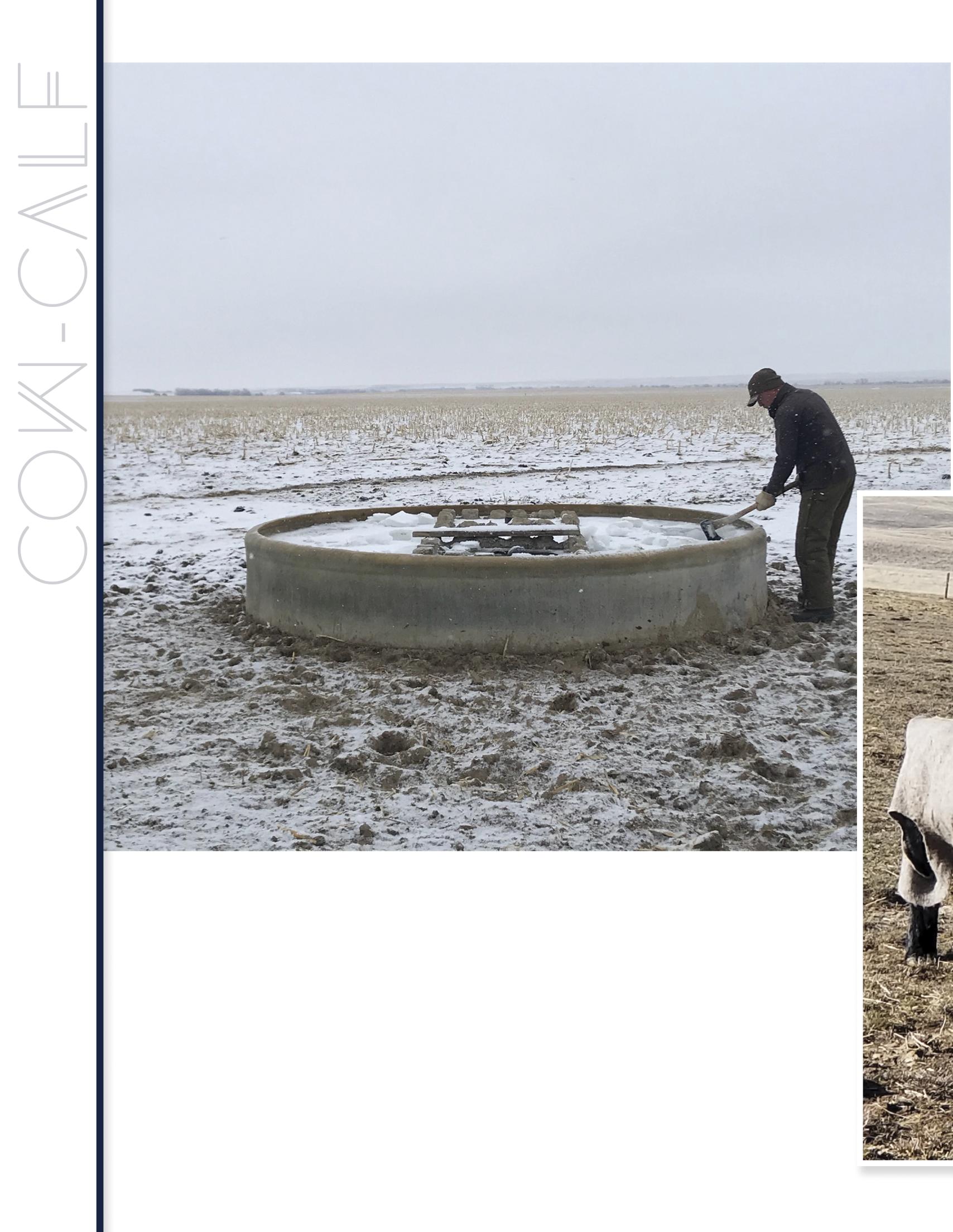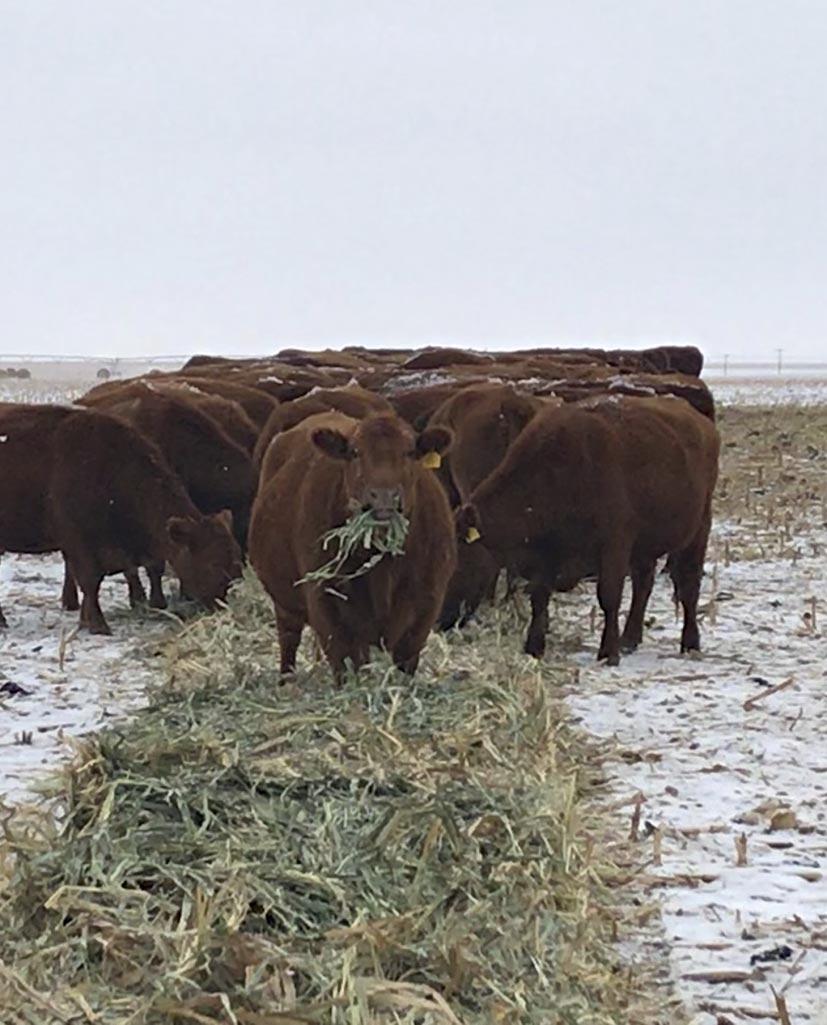
5 minute read
Tips for Battling Cold Weather Stress
By Clint Hilt, DVM, Hilt Veterinary Service, Production Animal Consultation
Cattle producers in the Northern Plains of the United States are no strangers to battling cold weather conditions. While Mother Nature will continue to have a mind of her own, there are a variety of steps that producers can take to improve environmental conditions and their herd’s preparedness before and during cold weather spells.
Advertisement
A fundamental concept when understanding how cold stress affects the cow is lower critical temperature, defined as “the lowest temperature a cow can be exposed to before she needs to have changes metabolically to help her cope with cold stress.”[1] Lower critical temperature depends on body condition score (BCS), hair coat thickness, and whether the hair coat is wet or dry. Any action that can influence either environment (temperature and wind chill) or lower critical temperature can help the cow conserve energy.
As a general rule, cows require 1 kilogram per day protein during the last trimester of pregnancy. While this protein intake does not change the quality of colostrum, it does improve the calf’s vigor and ability to get up and nurse earlier. As temperatures fall, cows will require additional feed, a concern in years like this when hay prices are high. Loose mineral supplementation is also important, no matter what time of year calving occurs.
Operations can utilize different types of shelter for cows and calves, including heated barns, open-face sheds, and bedded wind breaks, depending on availability and the extremity of weather conditions. For producers who have access to all three types during extreme cold spells, cows and newborn calves can be housed in a heated barn for the first 24 hours post-partum, moved to an open-face shed for the next 24 hours, and then moved to bedded wind breaks. Straw is most commonly used for bedding; wood chips are another option. Regardless of bedding material, make sure to monitor its depth. If the bedding is too deep, calves may get laid on. Wind breaks help cut the wind chill factor. Angled wind breaks provide protected areas accessible to calves but not cows. Calf huts or calf shelters can also provide protection from wind but may create biosecurity and cleanliness concerns since they also block sunlight.
No matter where cows and calves are kept, they must have adequate access to water. While cows can supplement water intake by licking snow (if the snow is not hard or crusty), they must also have access to drinkable water. If necessary, chop ice regularly or haul water in, particularly in areas where reservoirs have dried out.
For calves, I must emphasize the importance of colostrum intake. Make sure calves get up to nurse; the sooner and more often, the better. If the calf cannot receive colostrum from its mother, provide the calf with colostrum from another cow (who does not need it for her own calf) or use a high-quality colostral-derived colostrum replacer (not a supplement).
Calf coats can also help improve calf comfort and energy preservation during cold weather. Calf coats come in both single use and reusable/washable varieties. Recently, I have worked with some producers trying out the single-use Fit N Forget™ Beef Calf Covers from Woolover Limited.[2] These calf coats can raise the temperature around the calf as much as 30 degrees F (as measured with a thermometer placed between the calf’s skin and the calf coat). Calf identification numbers can be written on the coats, and the coats generally last two to four weeks, although I have seen some coats last up to two months. Occasionally, cows may perceive coat-wearing calves as predators. Observe the cow’s behavior after fitting the calf and remove the calf coat if the bonding between the cow and calf is negatively affected. In my experience, no matter the size of the operation or time constraints, it is worth the money, time, and effort to use these calf coats. They can also be utilized for high-risk and valuable calves in controlled environments.
If calving during the height of winter weather continues to challenge your operation, moving your calving date may be worth considering, depending on nutrition, facilities, manpower, and past experience. Remember, more inputs often yield bigger calves while less inputs yield smaller calves.
Whether you battle a single snowstorm each year or multiple cold spells lasting weeks to months, these practices can help improve cattle welfare and production.
Resources
1. Preparing the Cow Herd for Cold Weather. UNL Beef, November 2013. https://beef.unl.edu/cattleproduction/ preparing-cow-herd-cold-weather
2. Fit N Forget™ Beef Calf Cover, Woolover Limited. http://www.woolover.co.nz/fit_n_forget.html
Dr. Clint Hilt is a veterinarian and owner of Hilt Veterinary Service in Dutton, Montana. His practice is located in north-central Montana, extending from the Alpine Meadows to the Breaks. Dr. Hilt strives to be current, in both practices and procedures, and thorough for its clients. Dr. Hilt received his DVM from Washington State University in 1989.











